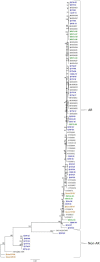Novel Human Parechovirus 3 Diversity, Recombination, and Clinical Impact Across 7 Years: An Australian Story
- PMID: 35867852
- PMCID: PMC9833435
- DOI: 10.1093/infdis/jiac311
Novel Human Parechovirus 3 Diversity, Recombination, and Clinical Impact Across 7 Years: An Australian Story
Abstract
Background: A novel human parechovirus 3 Australian recombinant (HPeV3-AR) strain emerged in 2013 and coincided with biennial outbreaks of sepsis-like illnesses in infants. We evaluated the molecular evolution of the HPeV3-AR strain and its association with severe HPeV infections.
Methods: HPeV3-positive samples collected from hospitalized infants aged 5-252 days in 2 Australian states (2013-2020) and from a community-based birth cohort (2010-2014) were sequenced. Coding regions were used to conduct phylogenetic and evolutionary analyses. A recombinant-specific polymerase chain reaction was designed and utilized to screen all clinical and community HPeV3-positive samples.
Results: Complete coding regions of 54 cases were obtained, which showed the HPeV3-AR strain progressively evolving, particularly in the 3' end of the nonstructural genes. The HPeV3-AR strain was not detected in the community birth cohort until the initial outbreak in late 2013. High-throughput screening showed that most (>75%) hospitalized HPeV3 cases involved the AR strain in the first 3 clinical outbreaks, with declining prevalence in the 2019-2020 season. The AR strain was not statistically associated with increased clinical severity among hospitalized infants.
Conclusions: HPeV3-AR was the dominant strain during the study period. Increased hospital admissions may have been from a temporary fitness advantage and/or increased virulence.
Keywords: Australia; HPeV3; community; infants; parechovirus; pediatric; picornavirus; recombination; sepsis; viral evolution.
© The Author(s) 2022. Published by Oxford University Press on behalf of Infectious Diseases Society of America.
Conflict of interest statement
Potential conflicts of interest. All authors: No potential conflicts. All authors have submitted the ICMJE Form for Disclosure of Potential Conflicts of Interest. Conflicts that the editors consider relevant to the content of the manuscript have been disclosed.
Figures





Similar articles
-
Evolutionary and network analysis of virus sequences from infants infected with an Australian recombinant strain of human parechovirus type 3.Sci Rep. 2017 Jun 20;7(1):3861. doi: 10.1038/s41598-017-04145-2. Sci Rep. 2017. PMID: 28634337 Free PMC article.
-
Evolutionary analysis of human parechovirus type 3 and clinical outcomes of infection during the 2017-18 Australian epidemic.Sci Rep. 2019 Jun 20;9(1):8906. doi: 10.1038/s41598-019-45445-z. Sci Rep. 2019. PMID: 31222066 Free PMC article.
-
[Human parechovirus associated sepsis and central nervous system infections in hospitalized children].Zhonghua Er Ke Za Zhi. 2014 Jun;52(6):444-8. Zhonghua Er Ke Za Zhi. 2014. PMID: 25190165 Chinese.
-
Human parechovirus type 3 infection: An emerging infection in neonates and young infants.J Infect Chemother. 2017 Jul;23(7):419-426. doi: 10.1016/j.jiac.2017.04.009. Epub 2017 May 13. J Infect Chemother. 2017. PMID: 28511987 Review.
-
[Human Parechoviruses].Uirusu. 2015;65(1):17-26. doi: 10.2222/jsv.65.17. Uirusu. 2015. PMID: 26923954 Review. Japanese.
Cited by
-
First whole genome sequencing and analysis of human parechovirus type 3 causing a healthcare-associated outbreak among neonates in Hungary.Eur J Clin Microbiol Infect Dis. 2024 Dec;43(12):2341-2350. doi: 10.1007/s10096-024-04950-4. Epub 2024 Sep 27. Eur J Clin Microbiol Infect Dis. 2024. PMID: 39331310 Free PMC article.
-
Genome Announcement of Four Parechovirus A3 Isolates from the United States of America.Int J Mol Sci. 2025 May 5;26(9):4378. doi: 10.3390/ijms26094378. Int J Mol Sci. 2025. PMID: 40362615 Free PMC article.
References
-
- Romero JR, Selvarangan R. The human parechoviruses: an overview. Adv Pediatr 2011; 58:65–85. - PubMed
-
- Harvala H, Calvert J, Van Nguyen D, et al. . Comparison of diagnostic clinical samples and environmental sampling for enterovirus and parechovirus surveillance in Scotland, 2010–2012. Euro Surveill 2014; 19:pii20772. - PubMed
-
- Yamamoto SP, Kaida A, Naito T, et al. . Human parechovirus infections and child myositis cases associated with genotype 3 in Osaka City, Japan, 2014. J Med Microbiol 2015; 64:1415–24. - PubMed
-
- Benschop KS, Schinkel J, Minnaar RP, et al. . Human parechovirus infections in Dutch children and the association between serotype and disease severity. Clin Infect Dis 2006; 42:204–10. - PubMed
Publication types
MeSH terms
LinkOut - more resources
Full Text Sources
Research Materials

